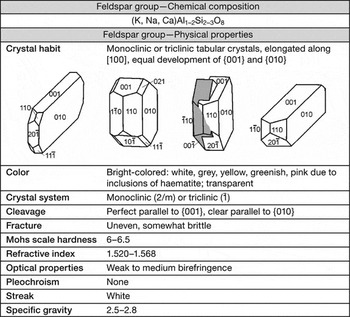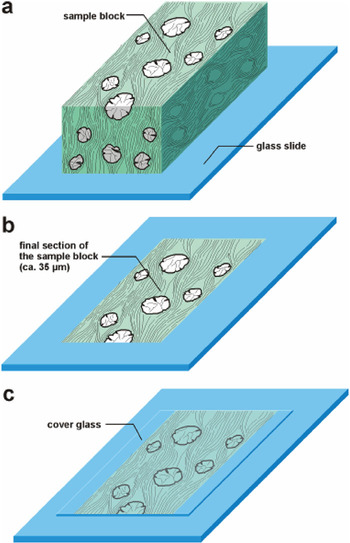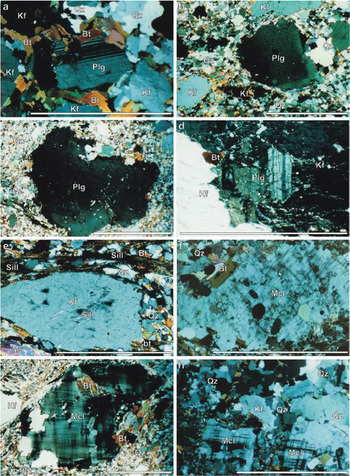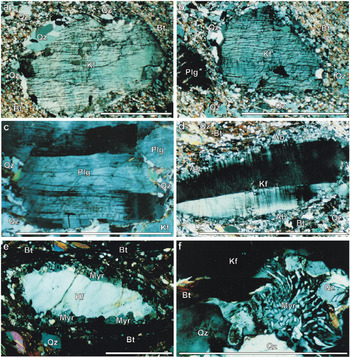Introduction
Feldspar is the name for a mineral group consisting of nearly 20 triclinic or monoclinic mineral species, of which only nine are well documented and widely distributed in the Earth's crust. Single members of the feldspar group belong to the so-called framework—or tectosilicates, where SiO4- and AlO4-tetrahedra share all their oxygen ions, resulting in an infinite three-dimensional network [Reference Deer, Howie and Zussman1]. Feldspar crystals include the major elements K, Na, Ca, Al, as well as Si and thus may be attributed to one of the following three endmembers: potassium-feldspar (K-feldspar) KAlSi3O8, albite NaAlSi3O8, or anorthite CaAl2Si2O8 (Table 1). Solid solutions occur between K-feldspar and albite, forming what is commonly known as alkali feldspar, and between albite and anorthite, forming plagioclase. The alkali feldspar group consists of orthoclase, microcline, sanidine, and anorthoclase, whereas the plagioclase group includes albite, oligoclase, andesine, labradorite, bytownite, and anorthite [Reference Barth2].
Table 1. Chemical composition and physical properties of the feldspar group.

An interesting question concerns the natural occurrence of feldspar. Minerals belonging to this group chiefly crystallize from magmatic sources of both intrusive (plutonic) and extrusive (vulcanic) igneous rocks [Reference Deer, Howie and Zussman1]. In most of these rocks feldspar represents a major constituent with a volume portion ranging from 30 to 50%. If feldspar-bearing igneous rocks are subject to an extensive physical weathering, sediments may be formed that contain a significant amount of the feldspar phase. However, such feldspar sediments and sediment rocks (arkose) are quite rare because in most environments feldspar has a remarkable tendency to be altered to other substances such as clay minerals [Reference Parsons3]. A further important source of the feldspar group is metamorphic rocks, which were formed from precursor rocks containing feldspar minerals and/or all those major elements required for their crystallization. Although anorthite and orthoclase are commonly found in medium- to high-grade metamorphic gneisses and schists, albite and oligoclase mainly crystallize in low- to medium-grade metamorphites. An interesting metamorphic occurrence may be attested to the mineral sanidine, whose preferential formation takes place under conditions of high-temperature contact metamorphism [Reference Parsons3]. Finally, feldspar minerals occur in pegmatites and veins where they crystallize from fluids containing all source elements necessary for their formation. In the case of slow continuous crystal growth, minerals may reach sizes of several centimetres [Reference Deer, Howie and Zussman1].
In the present contribution, the microscopic and microchemical characteristics of feldspar are introduced to microscopists interested in mineralogy. The detailed description of the mineral is conducted using samples from igneous and metamorphic rocks exposed at the southwestern margin of the Bohemian Massif in Austria (see geological map in Figure 1).

Figure 1. Geological map illustrating the position of the sample rocks within the Bohemian Massif. a) Sketch of central Europe providing an overview of the geographic position of the Variscan basement. b) Geological detail map of the Bohemian Massif with its main tectonometamorphic units. Square and arrow indicate the position of the study area.
Microscopy and Microanalysis of Feldspar
One part of each rock sample taken at a predefined location within the Bohemian Massif was used for the production of thin sections that served for light microscopy (Figure 2). Respective investigations were conducted on a petrographic microscope (ZEISS POLYVAR), appropriately equipped for bright- and dark-field microscopy. In addition to the petrographic thin sections, polished bulk specimens were used for microchemical investigations and backscattered electron imaging (BSEI). Both procedures were carried out on a JEOL JXA-8600 microprobe at the former Institute of Geology, University of Salzburg. The main operating parameters were as follows: 30-nA beam current, 15-kV accelerating voltage, 10-second counting time for each element except Na (30 s), and a constant beam diameter of 1 µm. Wavelength-dispersive spectrometer (WDS) crystals used for elemental analysis included lithium fluoride (LiF), pentaerythritol (PET), and thallium acid phthalate (TAP). Natural and synthetic silicates as well as oxides served as standards for the main element analyses [Reference Sturm4]. Correction of the raw analyses was carried out by the application of an system-internal ZAF-4 procedure provided by JEOL. The average calculated precision of the standardized element analyses was on the order of 0.1 wt. %.

Figure 2. Steps for the preparation of petrographic thin sections used for light microscopy. a) Fixation of the sample block on the glass slide. b) Grinding and polishing of the sample block until a final thickness of ca. 35 µm is reached. c) Covering of the thin section with Canada balsam and a thin cover glass. Polished thin sections used for EMPA are made in a very similar way. Instead of covering the surface of the section, a final polishing process is carried out producing a perfect section plane.
Rock Samples Containing Feldspar Minerals from the Bohemian Massif
Rock samples used here for the investigation of feldspars are from the exposed south-western margin of the so-called Bohemian Massif (Figure 1b), a huge Variscan mountain belt that can be assigned to the central-European Moldanubian zone. Within this large-scale tectonometamorphic unit, widespread high-temperature/low-pressure metamorphism, as well as partial melting processes (anatexis) and extensive plutonism, form the geology of the study area. The sample rocks belong to the Variscan migmatites and gneisses of the so-called Monotonous series, a part of the Drosendorf terrane (Figure 1b) and to those Variscan and post-Variscan granite bodies that have intruded the nappes of the Monotonous series [Reference Frasl and Finger5].
Pearl gneiss (Sample no. 1, Figures 3b and 3d), a dark rock rich in biotite, exhibits highly variable percentages of the major mineral constituents (plagioclase, biotite, K-feldspar, quartz, and cordierite). Plagioclase (oligoclase) represents the most impressive mineral phase because of its macroscopic appearance as white pearl- or pill-shaped crystals with diameters up to 1 cm.

Figure 3. Igneous rocks sampled for the investigation of feldspar: (a) and (f) ultramylonite, (b) and (d) pearl gneiss, (c) coarse grained gneiss, (e) Weinsberg granite. As can be already recognized from the images, macroscopic appearance of feldspar (Kf = K-feldspar, Plg = plagioclase) is subject to high variability concerning the size and shape of single crystals.
Coarse-grained gneiss (Sample no. 2, Figure 3c) is also characterized by an enhanced plagioclase content (up to 40 vol. %) forming irregularly shaped aggregates (“Schlieren”) and layers in the rock. Further mineral constituents include K-feldspar, quartz, and biotite.
Weinsberg granite (Sample no. 3, Figure 3e) is a rock within which K-feldspar occurs as large tabular crystals with variable idiomorphy and respective diameters ranging from 1 to 10 cm. The matrix surrounding the feldspar grains is composed of quarz, biotite, and negligible amounts of plagioclase.
Ultramylonite (Sample no. 4, Figures 3a and 3f) was introduced in part I of this investigation [Reference Sturm4] as a fine-grained metamorphite containing equal amounts of plagioclase and K-feldspar clasts (up to 3 cm in diameter). It also contains quartz, biotite, and a considerable volume portion of cordierite.
Microscopy and Microanalysis of Feldspar Crystals
Light microscopy
Under the microscope, feldspar crystals are easy to recognize and to distinguish from other mineral phases because of the following: First, the grains are frequently characterized by their appearance as large clasts embedded in a fine matrix of minerals that were formed from the magma during later stages of crystallization or from metamorphic fluids by recrystallization processes (Figures 4, 5). Second, feldspar grains may exhibit individual types of twinning that can be only observed in dark-field (crossed nicols). Therefore, plagioclase is marked by a so-called polysynthetic twinning, forming with a sequence of dark and bright stripes (Figures 4a, 4b, 5c). The K-feldspar phase (orthoclase) also may be twinned (Figure 5d), but in most cases appears as a homogeneously colored mineral under the microscope. A remarkable exception from this role may be noted for the alkali-feldspar microcline (Figures 4f–4h) that has a very typical appearance in dark-field known as “microcline lattice” (Figures 4f–4h). The grains are subdivided into bands of dark and bright zones. Third, feldspar crystals frequently contain a high quantity of mineral inclusions, whereby the number of included phases is positively correlated with the size of the host minerals (Figures 4d–4g). The so-called primary mineral inclusions are formed during the crystallization of the host minerals from the magma, whereas the secondary mineral inclusions are formed in the fully crystallized host phases during alteration processes. Primary mineral inclusions are important for the determination of mineral crystallization sequences in different magma types. In the case presented here, feldspar mainly includes quartz, biotite, other feldspar (Figure 4d), and accessory minerals such as zircon, rutile, titanite, and ilmenite. Secondary inclusions are mainly represented by sillimanite (fibrolite, Figure 4e) and garnet, which both are formed under conditions of high-temperature metamorphism.

Figure 4. Appearance of feldspar under the light microscope: (a) coarse-grained gneiss; (b), (c), and (e) ultramylonite; (d) and (f) Weinsberg granite; (g) and (h) pearl gneiss. Bars indicate a length of 1 mm, respectively. Abbreviations: Bt = biotite, Kf = K-feldspar, Mcl = microcline, Plg = plagioclase, Qz = quartz, Sill = sillimanite.

Figure 5. Mechanical deformation, high-grade metamorphic alteration, and retrograde de-composition of feldspar, photographically documented for the exemplary case of the ultramylonite, which was formed at a temperature of ca. 600 °C and a lithological pressure of ca. 3.5 GPa. (a) and (b) show brittle deformation of feldspar with formation of cracks, (c) plastic deformation of plagioclase, (d) high-grade metamorphic core-mantle texture, and (e) and (f) retrograde myrmekite (Myr) formation according to equation (1) (see text).
Compositional analysis
Electron microprobe analysis of feldspar crystals shows similar chemical compositions among the different feldspar types (Samples 1–4 in Table 2). Hence, K-feldspar is commonly characterized by SiO2 concentrations varying between 64 and 66%, Al2O3 contents ranging from 16 to 19%, K2O contents ranging from 15 to 16% and Na2O concentrations being on the order of 0.6 to 0.9%. The content of CaO may be considered negligible in most cases. This chemistry results in a clear predominance of the orthoclase component (90–93%), followed by albite (6–8%), and anorthite (0.1–1%). K-feldspar from the Weinsberg granite (Sample 3) sometimes shows an enhanced content of Na2O (up to 7.5%) at the cost of K2O (Table 2), resulting in a significant shift of the composition towards the albite component. For plagioclase, the concentration of SiO2 is usually less than that in K-feldspar (61–63%), whereas the content of Al2O3 is increased (23–25%). The CaO content varies between 4 and 5%, K2O shows a concentration of 0.2 to 0.4%, and the concentration of Na2O ranges from 8 to 9% (Table 2). This chemistry leads to a considerable predominance of the albite component (74–76%), followed by anorthite (23–24%), and orthoclase (1–2%). Although these analyses are specific for the rocks introduced here, they may be also evaluated as representatives for single feldspar groups [Reference Deer, Howie and Zussman1].
Table 2. Results of microchemical analysis (wt%) of four feldspars in K-feldspar and plagioclase: Sample 1 (S1) = pearl gneiss, Sample 2 (S2) = coarse-grained gneiss, Sample 3 (S3) = Weinsberg granite, Sample 4 (S4) = ultramylonite. Stoichiometric feldspar formulae and single feldspar components presented in the lower part of the table were computed assuming 16 oxygen atoms per unit cell.

Metamorphic Alteration and Retrograde Decomposition of Feldspar
High-grade metamorphic alteration of feldspar was studied in the ultramylonite (Sample 4). As determined by the garnet-cordierite Fe/Mg-exchange thermometer, this rock was subject to a ductile deformation that took place at temperatures of about 600 °C and lithological pressures of about 0.30–0.40 GPa [Reference Sturm6]. At the peak conditions of the metamorphic event, feldspar of the protolithic rock was involved in several alteration processes including the formation of fibrolitic sillimanite (Sill in Figure 4d) and garnet. In specific cases so-called core-mantle textures like that depicted in Figure 5d were produced where the rim of a large K-feldspar clast is transformed into aggregates of small recrystallized grains. Besides a chemical alteration based on extensive processes of element diffusion and transport of fluid phases, significant effects of mechanical influences on feldspar clasts may be observed in the rock samples of the ultramylonite. These mechanical forces are mainly expressed by cracks and fractures systematically running all over several grains (Figures 5a, 5b) or even by plastic deformations of single crystals (Figure 5c), resulting in their undulatory bending.
Under retrograde meta-morphic conditions, which are marked by a continuous decline of temperature and lithological pressure, K-feldspar is partly affected by a specific decomp-osition reaction resulting in the formation of fine (symplectitic) quartz and albite. This so-called myrmekite texture is usually produced at temperatures ≤ 500 °C and may be expressed by the following chemical reaction [Reference Barker7]:
In general two types of myrmekite textures may be distinguished, that is, the bulbous myrmekite with the symplectitic texture directly intruding into the adjacent K-feldspar (Figure 5f) and the corona-like myrmekite, where the decomposited feldspar is perfectly surrounded by a corona of the symplectitic texture (Myr in Figure 5e). In the latter case, quartz and albite are increasingly accompanied by muscovite. The second type of myrmekite texture preferentially occurs at the edge of feldspar crystals that are subject to increased deformational forces [Reference Barker7].
Conclusion
Feldspar with its structural and chemical variations represents a ubiquitous mineral phase occurring in many different types of igneous and metamorphic rocks. The mineral group is an interesting study object for microscopists because of its characteristic appearance in petrographic thin sections. Whereas plagioclase exhibits a so-called polysynthetic twinning with a variable number of dark and bright stripes, K-feldspar is either simple-twinned or untwinned. As demonstrated by feldspar rocks sampled at the southwestern margin of the Bohemian Massif in Austria, feldspar frequently forms the dominant mineral phase in granitic rocks, whereby large feldspar crystals (up to 10 cm in size) are commonly embedded in a matrix that is produced by the remaining mineral phases (that is, biotite, quartz, plagioclase, etc.). Under high-grade metamorphic conditions, K-feldspar is subject to specific transformation processes resulting, for example, in the formation of sillimanite, garnet, or albite and quartz. During retrograde metamorphic conditions occurring because of the uplift and cooling of the lithological unit, K-feldspar often undergoes a typical decomposition process (Formula 1) that leads to the production of fine symplectitic textures known as myrmekites. Because of their many shapes and sizes, such myrmekites might represent an interesting field for extensive microscopic analysis. Because all factors controlling feldspar formation and decomposition are not fully understood yet, the mineral will still be an object of mineralogical interest in the future.









